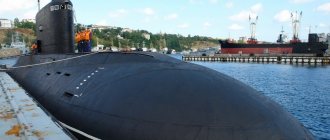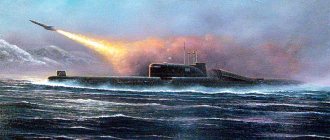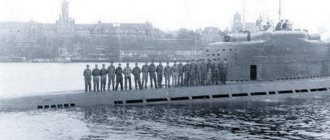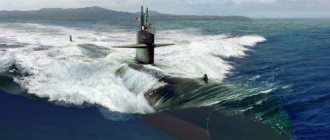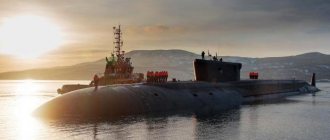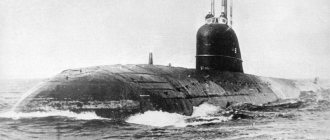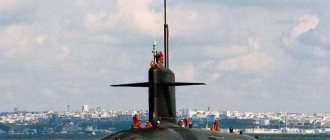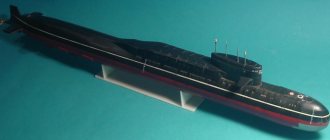The nuclear submarine pr. 971 (code "Bars") was developed at SPMBM "Malachite" under the leadership of G.N. Chernyshova. It belongs to the third generation PLA and is multi-purpose in the full sense of the word. It is designed to search, detect and track enemy SSBNs and AUGs, destroy them with the outbreak of hostilities, as well as strike coastal targets. If necessary, the boat can carry mines.
Nuclear submarine K-335 “Gepard” – video
Initially, the nuclear submarine Project 971 was considered as a “steel” analogue of the titanium nuclear submarine Project 945, intended to increase the pace of construction of third-generation submarines. However, the Malachite SPMBM, having extensive experience in designing multi-purpose boats, based on weapons, mechanisms and equipment created for Project 945, has essentially developed a new ship of the third generation. The quietest domestic nuclear submarines According to experts, the level of physical fields is comparable to such ships as the US Navy Seawolf nuclear submarine. The nuclear submarine pr. 971 is double-hulled and has a “limousine” fence for retractable devices, as well as a high stern tail, on which a fairing for the towed antenna of the sonar is located. The robust body is made of high-strength steel with a high yield strength (100 kgf/mm2) and is divided into six compartments by strong bulkheads.
All main equipment and combat posts of the Project 971 nuclear submarine are located on shock absorbers in zonal blocks, which are spatial frame structures with decks. Zone blocks are isolated from the boat hull by rubber-cord pneumatic shock absorbers. Thanks to the use of zonal blocks, it was possible to significantly reduce the level of the acoustic field, protect the crew and equipment from dynamic loads, and also rationalize the ship’s construction technology. In particular, the installation of equipment and systems was carried out in the workshop in a zone block, which was then inserted into the compartment shell. The lightweight body and the outer surface of the durable body are lined with a single rubber anti-hydrolocation and noise-absorbing coating. The ship has a traditional two-row TA arrangement. In the bow compartment there are racks for storing ammunition with longitudinal and transverse feed devices and UBZ. Under the TA there is a fence with the main antenna of the SAC. Some of the GAK and VSK antennas for the entire crew are located in the fencing of the wheelhouse and retractable devices.
The lightweight hull is shaped optimally for underwater travel. All holes and cutouts on it are covered with fairings. On the submarine pr. 97/ it was possible to implement comprehensive automation of combat and technical means, to concentrate control of the ship, its weapons and armament in the main command post. All this made it possible to reduce the crew to 73 people. Starting from K-263, on boats of Project 97/, SOKS is installed, and from K-391 - in the superstructure of the launcher for launching the hydroacoustic countermeasures complex, an emergency powder blowing system of the TsGB (powder generators) and emergency power networks. Simultaneously with the construction of ships of this type, a modernization program is being carried out, aimed at improving acoustic characteristics and expanding combat capabilities. In particular, the K-157 and K-335, while maintaining the same contours, have a mine insert of several meters for installing new equipment. Initially it was planned to build 20 submarines of Project 971. Head. No. 520 and head. No. 521, laid down in 1990 and 1991 respectively. at the Shipyard named after Lenin Komsomol, 03/18/1992 was excluded from the lists of the fleet. At this point, they had technical readiness of 25 and 12%, respectively. The backlog of equipment and mechanisms continues to be preserved at the construction plant.
As of December 2001, the fleet included 13 Project 971 submarines.
Nuclear submarine K-480 “Bars” (production number 821, from 07/24/1991, from 10/13/1997 “Ak-Bars” SMP (Severodvinsk): 02/22/1985; 04/16/1988 .; 12/31/1988. Was part of the Northern Fleet and carried out combat service in the Atlantic Ocean and the Mediterranean Sea. 04/06/1990, the boat made a deep-sea dive to the maximum depth. In 1998, she was expelled from the fleet's combat composition, transferred to ARVI for long-term storage and put into storage in the village of Gadzhievo.
Nuclear submarine K-317 “Panther” (serial number 822, from 10.10.1990). SMP (Severodvinsk): 06.11.1986; 05/21/1990; 12/30/1990 Part of the Northern Fleet. In September 1999, it was put into medium repair at SMP.
K-401 “Wolf” (serial number 831, from 07/26/1991). SMP (Severodvinsk): November 14, 1987; 06/11/1991; 12/29/1991 Part of the Northern Fleet. Completed two autonomous combat tours. From December 1995 to February 1996 in the Mediterranean Sea, the boat provided long-range anti-submarine cover for an aircraft carrier multi-purpose group led by TAVKR Admiral of the Fleet of the Soviet Union Kuznetsov
K-328 “Leopard” (serial number 832, from 01/24/1991). SMP (Severodvinsk): 10.26.1988; 06/28/1992; 12/15/1992 Part of the Northern Fleet Completed four autonomous combat services
K-154 “Tiger” (production number 833, from 07/24/1991). SMP (Severodvinsk): 09/10/1989; June 26, 1993; 12/29/1993 Part of the Northern Fleet Carried out two autonomous combat services From 1998 to 2002, it underwent maintenance repairs at the Northern Sea Fleet.
K-157 “Vepr” (serial number 834, from 04/06/1993). SMP (Severodvinsk): 07/13/1990; 12/10/1994; 11/25/1995 Part of the Northern Fleet. Performed one autonomous combat service and one search operation.
Nuclear submarine K-335 “Gepard” (serial number 835, from 02.22.1993). SMP (Severodvinsk): 09/23/1991; September 17, 1999; 05.12.2001 Part of the Northern Fleet.
K-337 “Cougar” (serial number 836, from 01/25/1994). SMP (Severodvinsk): 08/18/1992; Due to lack of funding, on January 22, 1998, construction of the ship was suspended. It is being preserved in one of the SMP workshops. The hull structures, mechanisms and equipment of the K-337 are expected to be used in the construction of the APKR Project 955 (code “Borey”).
K-333 “Lynx” (serial number 837, from 02/07/1995). SMP (Severodvinsk): 08/31/1993. Due to lack of funding, on 10/06/1997 the construction of the ship was suspended. It is being preserved in one of the SMP workshops. The hull structures, mechanisms and equipment of the K-333 are expected to be used in the construction of the APKR Project 955 (code “Borey”).
K-284 “Shark” (serial number 501, from 04/13/1993). Shipyard named after Lenin Komsomol (Komsomolsk-on-Amur): November 6, 1983; 06/16/1984; 12/30/1984 The lead ship pr 971 was part of the Pacific Fleet. In 2001, it was expelled from the fleet's combat strength and transferred to ARVI for long-term storage.
K-263 “Dolphin” (serial number 502, from 04/13/1993). Shipyard named after Lenin Komsomol (Komsomolsk-on-Amur): 05/09/1985; 05/28/1986; 12/30/1987 Part of the Pacific Fleet and performs combat service in the Pacific Ocean.
K-322 “Sperm Whale” (plant No. 513, from 04/13/1993, Shipyard named after Lenin Komsomol (Komsomolsk-on-Amur): 09/05/1986; 07/18/1987; 12/30/1988 It is part of the Pacific Fleet and performs combat service in the Pacific Ocean.
K-391 “Kit”, “Bratsk” from 09/01/1997 Shipyard named after. Lenin Komsomol (Komsomolsk-on-Amur): 02/23/1988; 04/14/1989; 12/29/1989 Part of the Pacific Fleet and performs combat service in the Pacific Ocean.
K-331 “Narwhal” (production number 515, from 04/13/1993). Shipyard named after Lenin Komsomol (Komsomolsk-on-Amur): December 28, 1989; 06/23/1990; 12/31/1990 Part of the Pacific Fleet and performs combat service in the Pacific Ocean.
K-419 “Walrus”, “Kuzbass” from 01/29/1998 . Shipyard named after Lenin Komsomol (Komsomolsk-on-Amur): 07/28/1991; 05/18/1992; 12/31/1992 Part of the Pacific Fleet and performs combat service in the Pacific Ocean.
Nuclear submarine K-295 “Dragon”, “Samara” from 08/30/1999. Shipyard named after Lenin Komsomol (Komsomolsk-on-Amur): 11/07/1993; 08/05/1994; 07/28/1995 Part of the Pacific Fleet and performs combat service in the Pacific Ocean.
Nuclear submarine K-152 “Nerpa”. “Chakra” (INS Chakra) since January 23, 2012, when it was officially leased to the Indian Navy
Service history[edit]
Units of the Baltic Fleet saw action during World War I and patrolled the Baltic Sea on numerous occasions, despite being limited to a short operational season. During the ice-free season of 1915, they targeted German warships with little success, which were generally fast and well protected. In the 1916 and 1917 seasons they were used to attack German iron ore shipments along the Swedish coast, although without much success due to restrictions imposed by Swedish neutrality.
Three ships (" Bars"
,
Lioness
and
Cheetah
) were lost.
Two ( Unicorn
and
Eel
) were lost in maritime disasters, and two (
Trout
and
Yaz
) remained unfinished.
Two more ( Cougar
and
Vepr
) were designated as training ones.
With the outbreak of the Bolshevik Revolution and the outbreak of the Russian Civil War, surviving units in the Baltic were captured by the Soviets and took part in the fighting against the Allied intervention forces; in 1919 Pantera
sank the British destroyer Vittoria. [1]
The Black Sea units were unfinished during the First World War and were captured by German occupation forces before being surrendered to the Allies and the White Russian forces of General Wrangel. [1] With the end of the civil war, the surviving Bars
remained in service until the 1930s and were then scrapped.
Performance characteristics of the Project 971 Shchuka-B nuclear submarine
Displacement, t: — surface ……………………………………………………………….8 140 — underwater ……………………………………………………… ……………………… 10 500 Maximum length, m …………………………………………………….. 110.3 Maximum width of the hull, m ……………… ………………………………… 13.6 Average draft, m …………………………………………………………… 9.68 Architectural and structural type ………………double-hull Immersion depth, m: — working……………………………………………………………………. 480 – maximum………………………………………………………………. 600 Autonomy in terms of provisions, days……………………………………………………….100 Crew, people……………………………………………………… …………….73 Power plant: Main mechanisms. – type……………………………………………………………………………………….AEU – PPU: – brand…………………………………………………… ……………………..OK-9VM or OK-650M.01 - number x type of nuclear reactor………………………………………………………..1 x VVR — thermal power of the nuclear reactor, MW……………………………………………………190 – STU: — type……………………………………………………………… ………………….unit - quantity x power of GTZ, l. s…………………………………………1 x 50,000 - number x power of ATG, kW……………………………………………………….2 x 3,200 – number x type of propulsors…………………………….. 1 x low-noise fixed propeller Backup energy sources and means of propulsion – number x power of diesel generators, kW…………………………………… ………1 x 800 – battery installation: – AB type………………………………………………………………lead-acid – quantity x RSD type………………… …………………………..2 x VPK - VPK drive x power, kW……………………………………………..ED x 300 Maximum travel speed, knots: – surface………………………………………………………..10 — underwater……………………………………………………………… ……………..33 Armament: Missile: - type of missile system…………………………………………. “Granat” - type of KRNS…………………… …………………………………………RK-55 - type of launch………………………………………………………………..underwater, from a 533-mm TA - type of MANPADS……………………………………………………………. “Strela-ZM” - number of containers for storing air defense systems……………………………3 - ammunition load for air defense systems……………………………………………………………… …….18 Torpedo. – quantity x caliber of torpedo, mm……………………………………4 x 650 — ammunition (type) of torpedoes……………………………..12 ( torpedoes 65-76 or PLUR …………………………………………………………..86R and 88R PARK “Veter”) - number x caliber TA, mm …………… ……………………………..4 x 533 – ammunition (type) of torpedoes and PLUR….28 (torpedoes USET-80 or PLUR 83R and 84R PARK “Vodopad”, or M5 PARK “Shkval”) - TA training system …………………………………………………… “Grinda” Radio-electronic: — BIUS ………………………………………………………..“ Omnibus" - NK…………………………………………………………….."Symphony" - KSS…………………………………………………………… …………………..“Molniya-MC” - SS system…………………………………………………..“Tsunami-BM” – GAK…………… ………………….“Skat-3” (MGK-540) – RLC…………………………………….“Radian” (MRKP-58) or “Radian” (MRKP-59) – tk…………………………………MTK-110 — periscope TK………………… “Signal-3” — commander’s periscope……………….. “Swan-11” or "Swan-21"
Ships[edit]
Baltic Fleet [1]
| Ship | Namesake | Builder | Launch date | Service/Fate |
| Bars BARS | (Leopard) [2] | Baltic Shipyard, St. Petersburg | June 2, 1915 | Lost May 1917; reason unknown |
| Cheetah CHEETHAH | (Cheetah) | Baltic Shipyard, St. Petersburg | June 2, 1915 | Sunk 28 October 1917 |
| Cougar COUGAR | (Puma) | Noblessner Yard, Revel | 1916 | Hulk 1922 |
| Leopard LEOPARD | (Leopard) [2] | Noblessner Yard, Revel | 1916 | Renamed Krasnoarmets . Hulk 1936 |
| Lviv LIONESS | (Lioness) | Noblessner Yard, Revel | October 23, 1915 | Sunk 11 June 1917 |
| Pantera PANTHER | (Panther) | Noblessner Yard, Revel | April 26, 1916 | Sank the British destroyer HMS Vittoria off Seiskari Island during the British Intervention in Russia. Axel Berg was the navigator at the time. The ship was renamed Komissar and converted into a port training ship in 1941. |
| Lynx LYNX | ( Lynx ) | Noblessner Yard, Revel | 1916 | Renamed Bolshevik , died in an accident on September 13, 1935. |
| Tiger TIGER | ( Tiger ) | Noblessner Yard, Revel | September 18, 1915 | Renamed Kommunar , fragmented in 1936 |
| Tur TOUR | (Bison) | Noblessner Yard, Revel | 1916 | Renamed Tovarich , sank in an accident on June 25, 1935. |
| Vepr VEPR | ( Boar ) | Baltic Shipyard, St. Petersburg | 1915 | Hulk 1922 |
| Wolf WOLF | ( Wolf ) | Baltic Shipyard, St. Petersburg | 1915 | Struck 1936 |
| Jaguar JAGUAR | (Jaguar) | Noblessner Yard, Revel | 1916 | Struck 1936 |
Black Sea Fleet [1]
| Ship | Namesake | Builder | Launch date | Service/Fate |
| Petrel _ | (Petrel) | Naval Plant, Nikolaev | 1916 | Captured by the Germans as SM US-1 and handed over to White Russian forces in 1918, interned at Bizerte with Wrangel's fleet and scrapped in 1924. |
| Loon LOON | (Loon/Diver) | Baltic (Admiralty) shipyard, Nikolaev | October 7, 1916 | Captured by the Germans as US 4 and scuttled April 26, 1919. |
| Swan SWAN | ( Swan ) | Naval Plant, Nikolaev | 1917 | Captured by the Germans and scuttled on April 26, 1919. |
| Orlan ORLAN | (Sea Eagle) | Naval Plant, Nikolaev | 1916 | Captured by the Germans as US 2 and scuttled April 26, 1919. |
| Pelican PELICAN | (Pelican) | Naval Plant, Nikolaev | September 1917 | Captured by the Germans and scuttled on April 26, 1919. |
| Duck DUCK | ( Duck ) | Baltic (Admiralty) shipyard, Nikolaev | 1916 | Captured by the Germans as 3 US and handed over to White Russian forces in 1918, interned at Bizerte and scrapped in 1924. |
Siberian Flotilla (served in the Baltic Fleet) [1]
| Ship | Namesake | Builder | Launch date | Service/Fate |
| Unicorn UNICORN | ( Unicorn ) | Baltic Shipyard, St. Petersburg | 1916 | Sunk on 25 February 1918. The ship's wreck was discovered on 28 May 2009 by the Estonian Maritime Museum in the northern Gulf of Finland. [3] |
Snake SNAKE | (Snake) | Baltic Shipyard, St. Petersburg | 1916 | Renamed Proletary , sank in an accident on 22 May 1931 |
| Eel EEL | (Eel) | Baltic Shipyard, St. Petersburg | 1916 | Sunk 27 March 1920 |
| Yaz Yaz | (Ide/Orphe) | Noblessner Yard, Revel | 1917? | Struck 1922 |
| Erzh ERSH | (Ruff) | Baltic Shipyard, St. Petersburg | 1917? | Converted to minelayer. Sunk in an accident on 22 May 1931. |
| Trout TROUT | ( Trout ) | Baltic Shipyard, St. Petersburg | 1916 | Converted to minelayer Struck 1922 |
